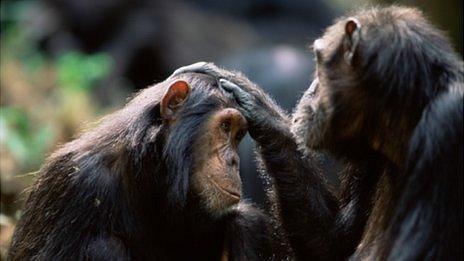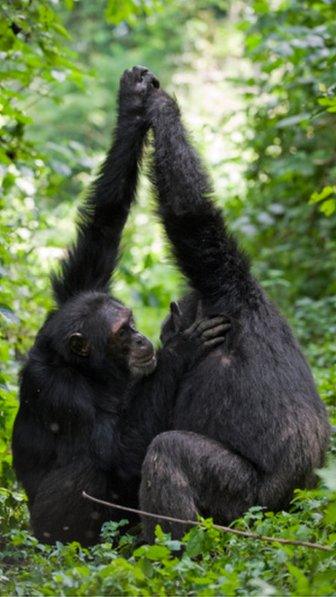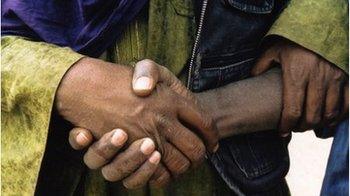Chimpanzee grooming is a 'postcode lottery'
- Published

The different styles of grooming behaviour were learned by social convention
Chimpanzee grooming habits are influenced more by where they live than by genetic or ecological influences.
That is the conclusion of a study in Proceedings of the Royal Society B, external.
Previous studies had shown that a specific style of grooming - grooming hand clasp (GHC) - was restricted to specific populations of chimpanzees.
By studying distinct communities of semi-wild chimps, the team identified different styles of GHC and showed they were learned by social convention.
These studies provide insights into how differences in social behaviours in human cultures and populations might have arisen.
GHC was first observed in the K(ajabala)-Group of chimpanzees living in the Mahale mountains of Tanzania.
During GHC, two chimpanzees raise one arm overhead and clasp each other's hands, whilst grooming one another with their free hand.
But not all chimpanzees groom in this way - animals in the nearby Gombe field-site never engage in GHC.
Why GHC is not pervasive throughout chimpanzee communities was the key question that Prof Edwin van Leeuwen, external from the Max Plank Institute for Psycholinguistics, the Netherlands, and his colleagues addressed.

Grooming hand clasp behaviour establishes close social bonds
Previous studies had shown natural variation in GHC style - including palm-to-palm, wrist-to-wrist and forearm-to-forearm clasping.
Prof van Leeuwen posited that a preference for a particular style would be "a strong indication that this behaviour follows cultural patterns".
The researchers recorded GHC behaviour in four social groups of semi-wild chimpanzees living in the Chimfunshi Wildlife Orphanage Trust (CWOT), external in the north west of Zambia. Half of the chimpanzees were wild-born, whilst half were reared in the orphanage.
The chimpanzees originated from all over Africa and groups were formed based on their date of arrival at the orphanage. This meant that any differences in behaviour would unlikely be due to genetic or ecological influences.
Commenting on the study design Prof Lydia Luncz from the Max Plank Institute for Evolutionary Anthropology, Germany, told BBC News: "In recent years, research has shifted from debating the existence of culture in great apes to trying to understand its underlying mechanisms. This study uses one of the rare opportunities to study wild animals in a semi-wild setting."
Of the four groups studied, two engaged in GHC behaviour - one had a preference for wrist-to-wrist GHC whilst the other preferred palm-to-palm.
Whilst not included in the published data, Prof van Leeuwen said: "Most, if not all, individuals engaged in almost all styles (palm, wrist, forearm, other) at least once.
"This is actually part of our argument against genetic influences: if all individuals/pairs can do everything, but just prefer one style over the other, then genetics are ruled out as an explaining factor."
Asked why chimpanzees engage in this unusual behaviour, he said: "There are many hypotheses out there as to why the chimpanzees (and some bonobos) engage in GHC behaviour, one of which is to (re-)establish close social bonds."

Chimpanzee studies could yield important insights into the evolutionary roots of our own culture
But, just as in human cultures, the behaviour isn't fixed. There is at least one published example of an individual in a non-GHC community who spontaneously started engaging in GHC and, over time, transferred this to other members of the group.
Commenting on the new findings, Prof Frans de Waal, director of the Living Links Centre at at Emory University's Yerkes Primate Centre, said: "This is a very nice study that contributes to the field by looking in more detail at a defined behaviour.
"The idea of chimpanzee 'culture' was originally supported by experimental studies in captivity that show how behaviour can spread by social learning.
"The present study goes beyond this in taking neighbouring communities (where genetics and ecology are the same) and finding substantial differences from group to group. This is an extra argument for social learning."
According to Prof Luncz, the findings also provide insight into how human social behaviour has evolved: "In many ways, chimpanzees are very similar to us humans and by studying the similarities to our closest living relatives, we have the unique opportunity to learn more about the evolutionary roots of culture, which is one of the key elements of our identity".
- Published9 June 2011